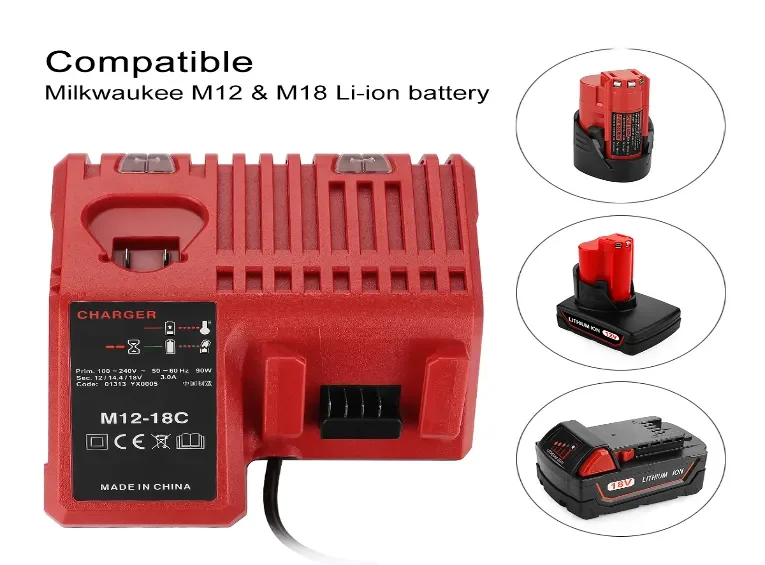5 Tips for Safely Using Your Milwaukee M18 Battery Charger
Protect your Milwaukee M18 charger and batteries—follow these five essential safety tips for reliable, long‑lasting charging performance.

1. Inspect and Maintain Charger Components
Regularly inspect and maintain every charger component to ensure safe, reliable operation: start by unplugging and cooling the unit, then examine the contact plates for pitting or corrosion—gently clean them with a lint‑free cloth dampened in isopropyl alcohol and allow them to dry fully. Check vents and cooling fans for dust buildup; use short bursts of compressed air to clear blockages and verify that the fan spins freely. Flex the power cord end‑to‑end to reveal hidden cuts or frays, and inspect the plug and strain relief for cracks. Finally, look over the housing for any signs of impact damage, loose screws, or warped plastic that could compromise internal insulation. By performing these checks monthly, you’ll catch wear early, maintain proper airflow and contact integrity, and prevent electrical or thermal faults before they arise.
Visual Cord & Housing Check
Before each use, scan the cord and housing for frays, exposed wires, cracks or loose connections. Damaged cords can arc or short—if you spot wear, stop charging and replace the cord or housing.
Contact Terminal Cleaning
Once a month, remove any batteries and wipe both charger and battery terminals with a lint‑free cloth lightly moistened with ≥ 70 % isopropyl alcohol. Dry completely before reconnecting to prevent heat buildup or intermittent contact.
2. Ensure Proper Ventilation & Placement
Position your Milwaukee M18 charger on a stable, non‑combustible surface with at least 5 cm of clearance on all sides so air can flow freely through its vents, and avoid placing it against walls, inside cabinets, or atop soft materials like carpet or cloth that could obstruct airflow. Keep the charger away from heat sources (radiators, direct sunlight) and moisture, and ensure the power cord isn’t pinched or coiled tightly around the unit. Good ventilation prevents internal overheating, maintains optimal charge currents, and extends the life of both charger and batteries.
Maintain Clearance Around Vents
Keep at least 10 cm (4 in) of space on all sides so intake and exhaust vents remain clear. Never place the charger in a crowded toolbox or under fabrics.
Avoid Soft or Flammable Surfaces
Charge only on hard, non‑combustible surfaces (concrete, metal bench, ceramic tile). Carpets, cardboard or solvent‑soaked areas can ignite if the charger runs hot.
3. Match Charger to Battery Platform
To ensure safe, efficient charging, always pair each Milwaukee charger with its intended battery platform: M12 chargers are engineered for two‑cell, 12 V packs and use different contact geometry and charging algorithms than the three‑cell, 18 V M18 chargers, which incorporate BMS routines and higher current outputs. Using an M18 charger on an M12 pack will either be rejected mechanically or risk overvoltage, while an M12 charger cannot deliver enough voltage to top off an M18 battery. Always verify the charger model number and label voltage before plugging in—this guarantees proper cell balancing, correct temperature monitoring, and long battery service life.
Use Only M18 Chargers for M18 Packs
Milwaukee M18 charger is calibrated for M18 batteries. Never insert an M12 or third‑party pack into an M18 charger—mismatched voltage or handshake profiles can damage the BMS.
Verify LED Handshake
A compatible pack will show a steady red LED, then switch to green once charging is complete. Rapid red/green flashes or no transition indicate a mismatch or BMS fault—remove the pack and double‑check compatibility.
4. Control Environmental Conditions
Always operate and store your charger and batteries in a stable, controlled environment: keep ambient temperatures between 10 °C and 40 °C (50 °F–104 °F) to prevent thermal cut‑outs or cold‑weather lockouts, and maintain relative humidity below 50 percent to avoid condensation or corrosion. Position units on a flat, dust‑free surface away from direct sunlight, radiators, steam or chemical vapors, and never in uninsulated garages. Good lighting and airflow help you spot contaminants early and ensure cooling vents remain unobstructed, preserving both performance and safety.
Operate Within Safe Temperatures
Charge and store between 5 °C and 40 °C (41 °F–104 °F). Below 5 °C, lithium‑ion plating may occur; above 40 °C, thermal cut‑outs will suspend charging.
Keep Dry and Dust‑Free
Avoid high‑humidity or dusty workspaces. If outdoors, shelter the charger and clear any debris from vents after each use.
5. Prepare for and Respond to Emergencies
Always keep an ABC‑rated fire extinguisher and a bucket of sand or inert absorbent material within reach of your charging station, and make sure all users know its location and how to operate it. If you detect smoke, sparks, or hissing from a charger or battery, immediately unplug the unit (using insulated gloves if available), move it outdoors or into a well‑ventilated area on a nonflammable surface, and extinguish any flames with your chosen method—never use water on a lithium‑ion fire. Call emergency services if the situation escalates or if toxic fumes persist, and document the incident for warranty or service claims. Afterward, allow all equipment to cool and off‑gas fully before inspecting or disposing of damaged packs according to local hazardous‑waste regulations.
Have Fire‑Safety Gear Ready
Keep a Class C fire extinguisher within reach whenever charging multiple packs or running back‑to‑back cycles in an enclosed area.
Recognize Error Indicators
Learn your charger’s LED codes. Rapid red/green flashes signal BMS protection—immediately unplug, let the pack cool, then inspect both charger and battery before retrying.
By regularly inspecting components, securing clear airflow, matching platforms, controlling the environment, and planning for emergencies, you’ll extend the life of your Milwaukee M18 charger and batteries while keeping your workspace safe.
For Milwaukee replacement parts and in‑depth maintenance guides, visit XNJTG.